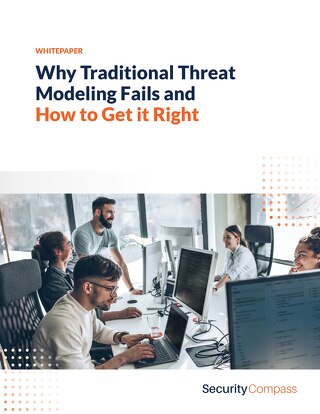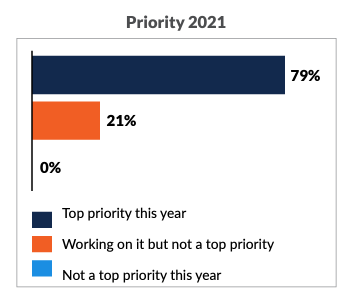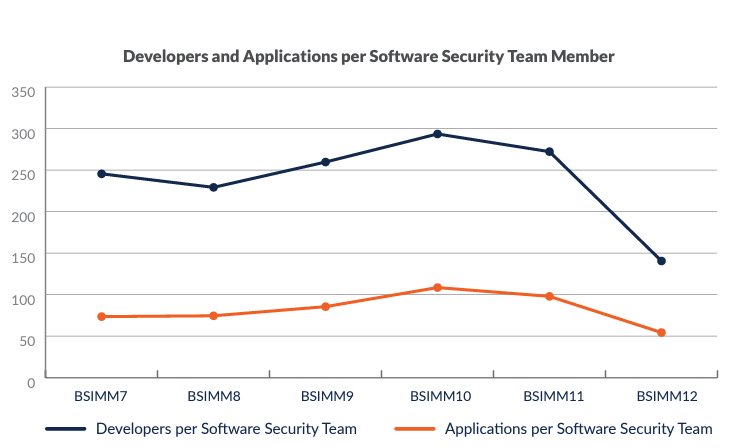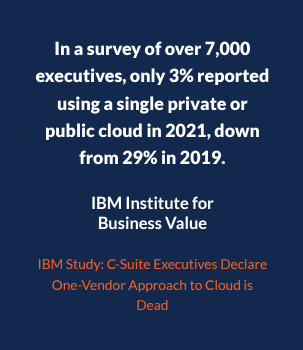Why threat modeling is important
Security professionals know they can accelerate development and reduce unnecessary security rework through threat modeling. Threat modeling examines an application’s technology stack, deployment environment, and applicable regulatory requirements to anticipate security issues. This allows developers to build appropriate controls as part of the normal development cycle. It is unsurprising, then, that threat modeling is a top priority for organizations.
Traditional threat modeling requires development and security resources to diagram an application, establish trust boundaries, and assign threat mitigation controls. While valuable, this process can take weeks. In the rapidly changing development environment found in most organizations today, traditional threat modeling faces a multitude of challenges.
The 2021 State of Threat Modeling: An interactive e-book publication
Why traditional threat modeling fails
The threat modeling process has value for security personnel and business owners. Increasingly hostile cyber criminals can disrupt operations, damage brand reputation, and bring increased regulatory scrutiny. Testing for security issues late in the development process results in additional blockers in the product release pipeline.
Popular threat modeling techniques like STRIDE and PASTA are largely manual. A few threat modeling tools have been digitized (from paper- or whiteboard-based exercises) and incorporate some automation capabilities. However, business owners, technical managers, and security personnel still face several challenges when implementing manual threat modeling initiatives.
Scalability
Scalability is one of the common challenges with traditional threat modeling. Security expertise remains scarce—even in organizations with formal software security teams. The 2021 BSIMM survey found an average ratio of one Software Security Group member per 140 software developers. Looking at the findings another way, each software security team member supported over 50 applications.
With ratios like this, it is obvious that organizations lack the resources to devote senior personnel to multi-day exercises for each project or application. As a result, only the most critical applications are modeled prior to the project’s beginning. This leaves the majority of an organization’s application portfolio potentially vulnerable to attacks and ignores legacy applications already deployed.
Completeness and control implementation
By design, manual threat modeling typically focuses on a subset of security threats and mitigations for software and its environment and falls short of detailing and prioritizing technical steps that software development teams can execute. Similarly, mitigations generated by semi-automated threat modeling tools are not prescriptive enough for developers. This typically requires that security experts support developers’ post-threat analysis to implement the mitigations.
Consistency
The thoroughness and effectiveness of a manual threat modeling exercise are dependent on the experience, skill, and judgment of those conducting it. Different people building the threat models have different expectations of what a threat is, what the threat model should look like, and how the threats should be ranked. This inconsistency has a downstream repercussion on aligning on the biggest threats and, therefore, which threats development teams should prioritize. A lack of standardized processes leads to inconsistent outputs. Incomplete and inconsistent threat and control identification results in missed threats and non-standard controls. Changing regulatory standards further complicates assigning correct controls, even when organizational policies are in place.
Validation and auditability
The validation of appropriate risk mitigation controls should be part of every project. Unfortunately, most threat modeling solutions do not integrate well with issue trackers (to streamline the assignment of recommended controls to development teams) or scanning tools (to verify that mitigations have been implemented). Verifying controls using spreadsheets and shared documents is inconsistent, and updates by email are subject to misinterpretation, providing poor evidence of compliance with corporate policies and regulatory standards. Manual methods also make it difficult to provide management and auditors with a clear picture of an organization’s security profile across all projects.
Complexity
Manual threat modeling was adequate for large codebases with a well-understood and static architecture. Today’s applications do not follow this model. The move to the cloud, the adoption of rapid development methodologies, and the need to adapt quickly to changing market demands mean new features and functionality are constantly added. Increased use of microservices and layered architecture results in an everchanging threat landscape. Manual threat models requiring days or weeks of effort no longer work.
Manual threat models reflect the original intent of a project’s design and implementation—a snapshot in time. As a project evolves, the original threat model quickly becomes obsolete. Integrations with other applications can alter the threat landscape. Moving from an on-premises deployment to the cloud – or changing cloud.
Providers – requires updated threat models. With a single application, this can be difficult. With hundreds or thousands of applications, manual threat models are impossible.
Developer pushback
Software development teams are incentivized to deliver a certain set of features and functionality by a specific date. Development friction occurs when there are dependencies on other teams to achieve the objectives of the project. Dependencies can create bottlenecks or increase the time and effort required to complete the activities.
In threat modeling exercises, these dependencies occur during the information-gathering phase when development input is required to scope out threats in the system under assessment or during the implementation of recommended mitigations when security guidance is required.
Gartner® reported that “three out of four software engineering teams report that they experience development friction, defined as unnecessary time and effort they must exert to achieve their objectives.”1 Further, almost half of the software engineering personnel surveyed reported experiencing friction in meeting architecture and security requirements.
How to threat model in a complex environment
To reduce cybersecurity risk at scale, organizations need a different approach to modeling software risk that tightly integrates with product workflows and empowers product teams to deliver secure products at high velocity. In a rapidly changing environment, manual and semi automated processes cannot keep up.
Automation of the threat modeling process with SD Elements provides this speed and security, along with scalability, consistency, and the ability to quickly understand the security profile of a single project or an entire portfolio.




